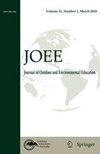家长和看护人对高风险户外游戏空间的好处的看法
IF 1.4
Q3 EDUCATION & EDUCATIONAL RESEARCH
引用次数: 0
摘要
成人的价值观、态度、行为和信仰是影响儿童冒险经历的因素。这项研究考察了成人在高风险公园环境中支持儿童玩耍和学习的作用。考虑到这一背景,我们的研究采用了两阶段混合方法来探索父母和照顾者对名为Boongaree的定制澳大利亚户外“自然游戏公园”的看法。从参与者(n = 302)收集的定量数据调查了游乐场的访问模式,定性数据收集了父母和看护者对公园的好处和挑战的见解。一个值得注意的发现是家长和看护人对孩子们在公园冒险游戏的强烈支持,以及公园如何支持孩子们的发展。从定性数据中得出的9个新兴主题表明,成年人支持他们的孩子参与这个高风险的公园,因为它提供了机会(1)参与一个创新的自然游戏公园,(2)挑战和解决问题,(3)连接到户外,(4)玩得开心,(5)指导他们自己的游戏,(6)身体活跃,(7)有创造力和好奇心,(8)展示自信和独立性,(9)建立社会能力。最后,我们的研究得出结论,父母和照顾者的风险偏好或风险承受水平是他们希望(或重新参与)孩子冒险自然游戏机会的主要因素之一。本文章由计算机程序翻译,如有差异,请以英文原文为准。
Parents’ and caregivers’ perspectives on the benefits of a high-risk outdoor play space
Abstract Adult values, attitudes, behaviours, and beliefs are factors that shape childhood exposure to risk-taking experiences. This study examined the role of adults in supporting children’s play and learning in a high-risk park environment. Considering this context, our research incorporated a two-phased mixed-methods approach to explore parent and caregiver perceptions of a bespoke Australian outdoor “nature play park” named Boongaree. Quantitative data collected from participants ( n = 302) investigated playground visitation patterns, and qualitative data were collected around parents’ and caregivers’ insights around the benefits and challenges of the park. A noteworthy finding that emerged was the parents’ and caregivers’ strong support of children’s risky play at this park and how the park supported the children’s development. Nine emergent themes from the qualitative data showed that the adults supported their children’s engagement with this high-risk park as it offered opportunities to (1) engage with an innovative nature play park, (2) be challenged and solve problems, (3) connect to the outdoors, (4) have fun, (5) direct their own play, (6) be physically active, (7) be creative and curious, (8) demonstrate confidence and independence, and (9) build social capacity. Finally, our study concluded that the risk appetite or risk tolerance level of parents’ and caregivers’ is one of the primary factors underpinning their desire to engage (and re-engage) with risky nature play opportunities for their child.
求助全文
通过发布文献求助,成功后即可免费获取论文全文。
去求助
来源期刊

Journal of Outdoor and Environmental Education
Social Sciences-Education
CiteScore
2.60
自引率
35.00%
发文量
28
期刊介绍:
The Journal of Outdoor and Environmental Education (JOEE) is a double-blind peer-reviewed journal devoted to the scholarly examination of issues in outdoor and environmental education. JOEE provides a forum in which outdoor and environmental education professionals from all settings can exchange and discuss ideas and practices relevant to their work.JOEE invites submissions of papers of between 4000 and 8000 words (including reference list and abstract) that focus on enhancing understanding of outdoor and environmental education issues through balanced and in-depth investigation of practices and theories relevant to outdoor and environmental education. Shorter book/document reviews are also welcomed.JOEE does not privilege any particular methodology or theory and welcomes contributions from various standpoints. However, editorial will prioritise papers that take into consideration a broad readership which includes teachers and other practitioners as well as researchers, requiring authors to express and explain evidence and theory using language that is accessible to readers beyond a particular community. With this in mind, we ask authors, on acceptance of their paper, to produce a short video which will be made accessible in order to share the main messages contained in their paper with a wide audience.
 求助内容:
求助内容: 应助结果提醒方式:
应助结果提醒方式:


